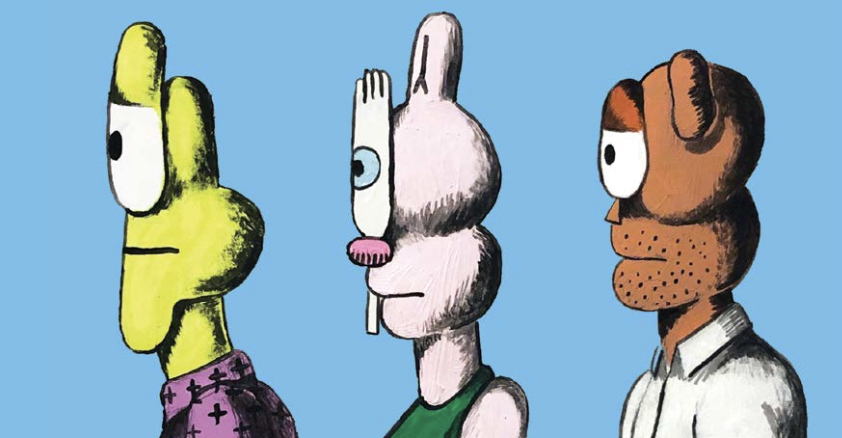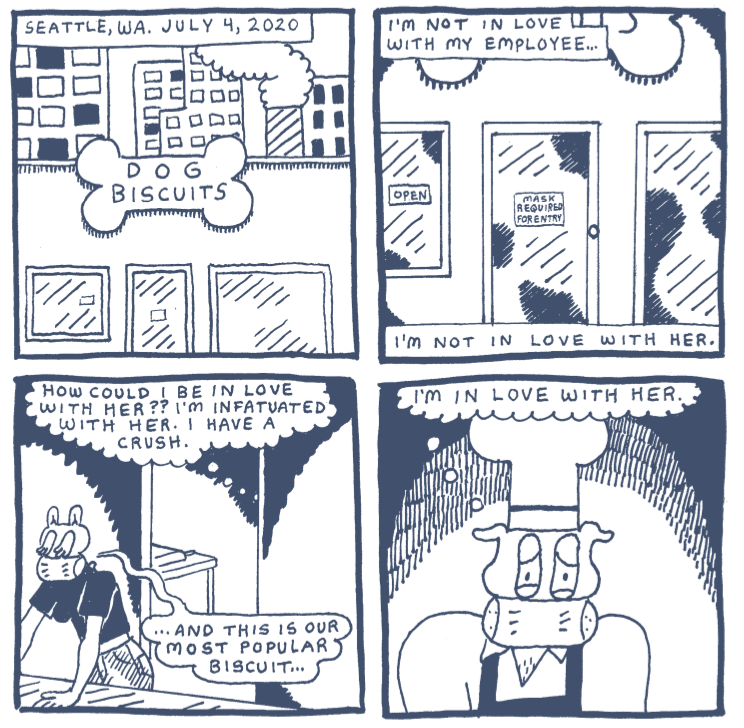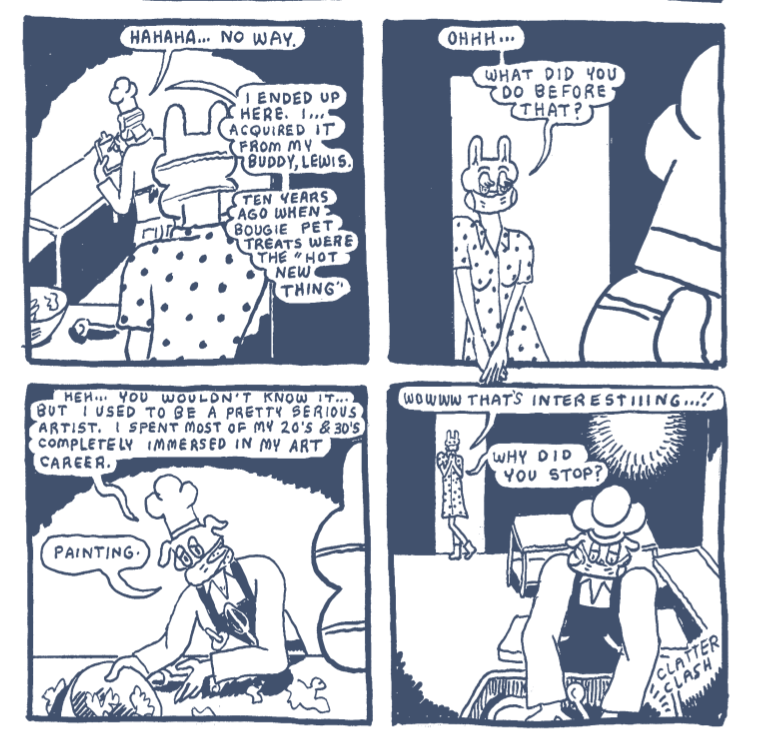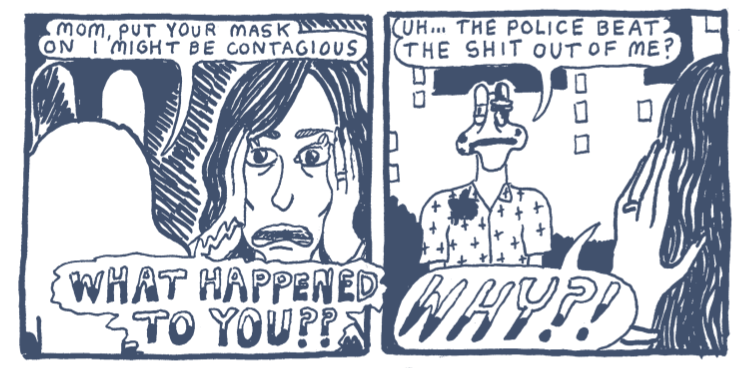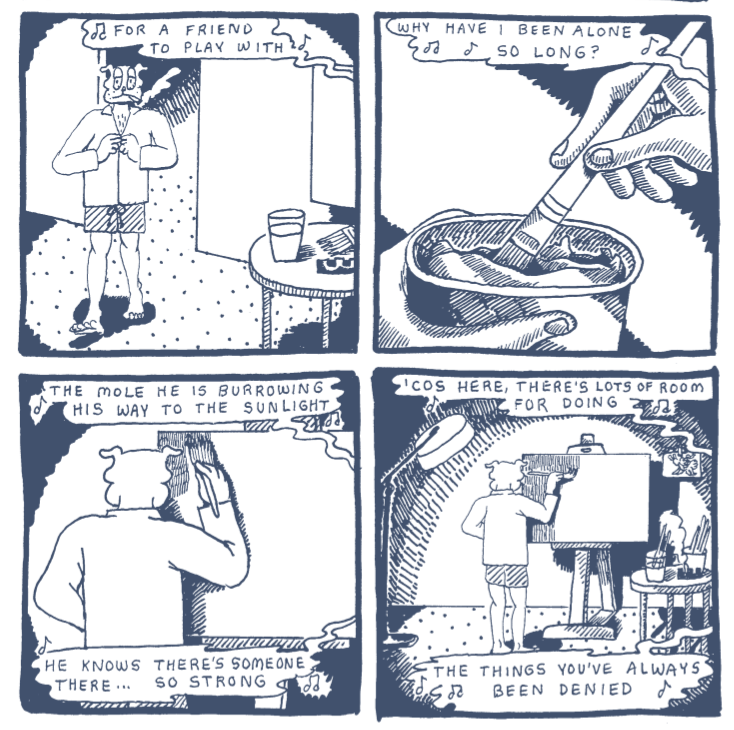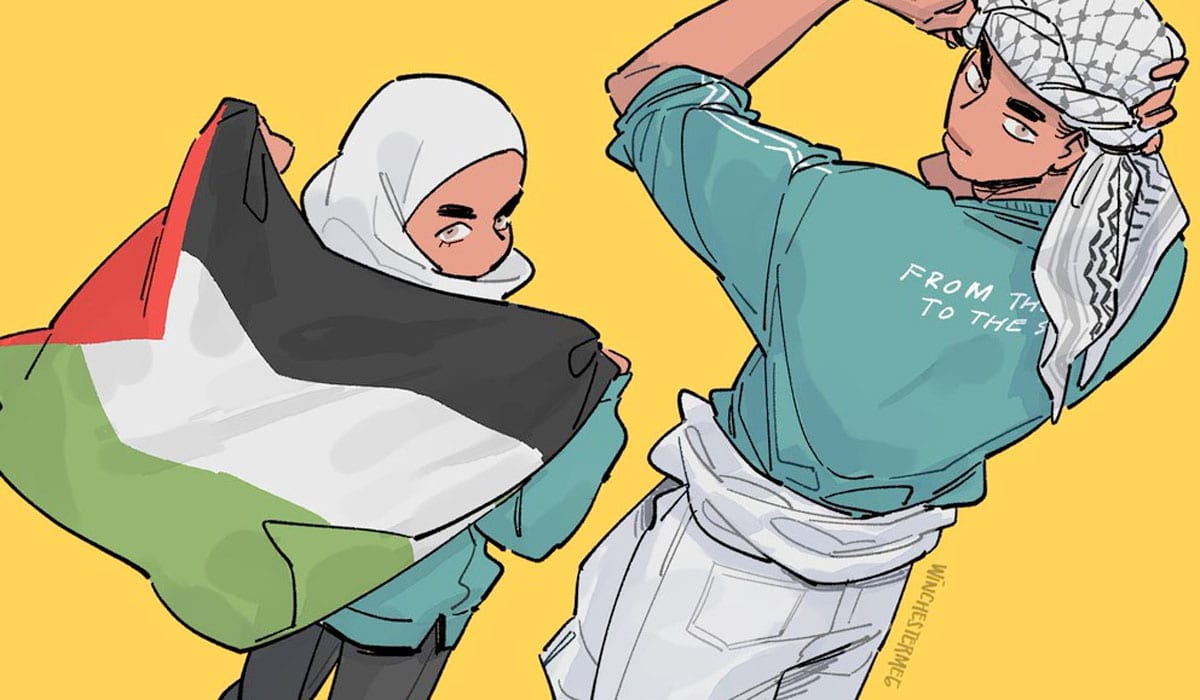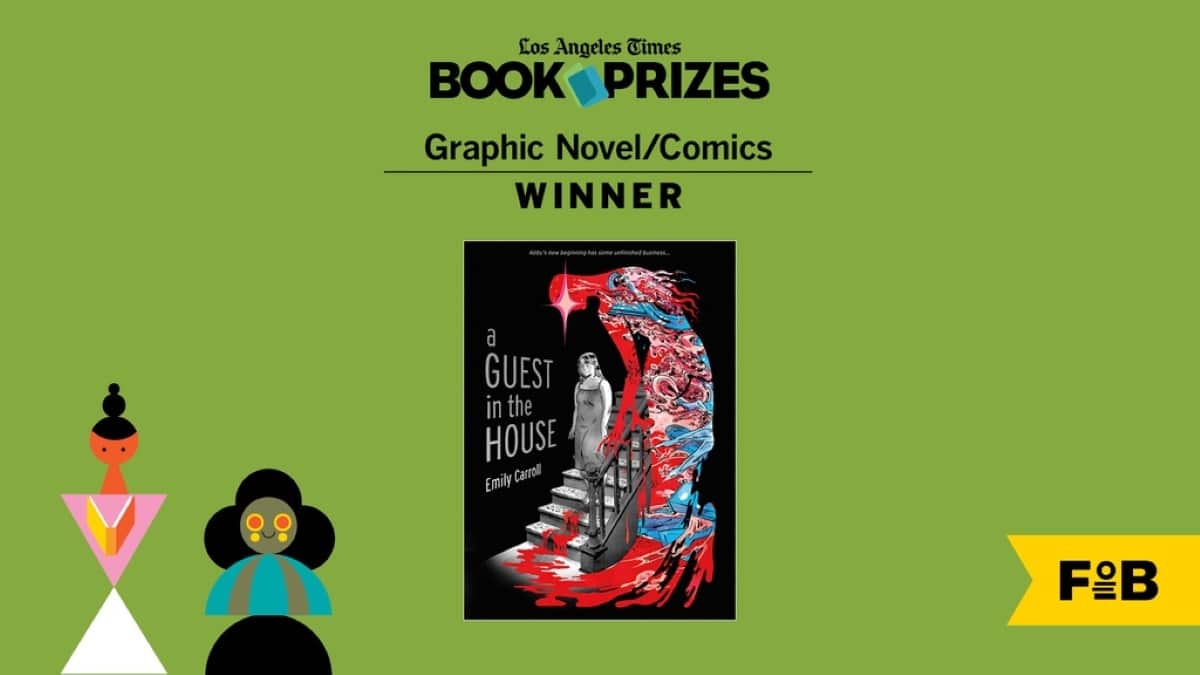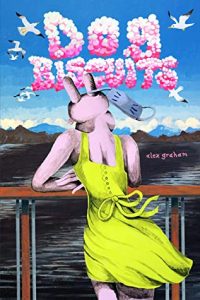
people animals as they attempt to navigate summer 2020 in Seattle. Released on Instagram during first year of the ongoing COVID-19 pandemic, the incredible comic has been collected in a single volume by Fantagraphics, available now.
The Beat got the opportunity to catch up with Graham over Zoom to inquire about her creative process, to discover when the comic’s climactic painting was created, and to learn all about how circumstances conspired to make the creation of the Cartoonist Studio Prize Award-winning comic possible (when capitalism would have otherwise prevented its creation).
AVERY KAPLAN: What was the genesis of the project? Did you have any idea of the characters or progression of the story in advance?
ALEX GRAHAM: The first one hundred pages are completely improvised, and I had no idea where the story was going. They were just improvised from one panel to the next. I would wake up that morning and see what had happened that day, and then write something based on what had happened that day in the pandemic.
But then eventually this bigger picture story started occurring to me. Especially after I got… I was drawing (probably) the first one hundred pages when I was still at work at a restaurant. After I got laid off from that job again, I had more time to focus entirely on the story and the entire story started occurring to me at that point.
KAPLAN: What was your creative routine like at the “height” of the project (which I guess would probably be post-layoff)?
GRAHAM: Yes. I would wake up in the morning and drink coffee and then sit down at my desk and start drawing. And on the days when I was creatively and mentally strong, I could draw, like, three pages, and I would be working from noon to eight PM and then just collapse into bed. And I was doing that most of the time.
I have a hormone sensitive disorder called PMDD that makes it so for about a week, a week in a half every month, I have to pretty much spend the entire week in bed. So during Dog Biscuits, I was actually trying to push through that as much as I could. I could only do maybe a half-a-page, or maybe a whole page during that week every month, but I was pushing through.
Now that I’m working on my new book, I’m not working during that week, because it’s too hard. But I wanted to finished Dog Biscuits so bad that I’d just push through. That definitely was something I had to… Probably the biggest challenge of working on the book.
KAPLAN: Was this project only possible because of COVID?
GRAHAM: Yes, because if it wasn’t for getting laid off… Yes. The entire project wouldn’t exist without COVID because when I was still employed, me and all my coworkers had to be there at the restaurant for fourteen hours a week because of the PPP loan that we received, and we weren’t getting any business. So were all just sitting there, twiddling our thumbs, scrolling. And I started drawing this to keep myself occupied. And if it wasn’t for COVID, I would have been doing my normal job, and then doing my normal routine.
Actually, I was supposed to become a restaurant manager right at the start of COVID. I was not looking forward to that. The very first day that I was supposed to train for that, that was when everybody started losing their job. It was so weird, it was a weird coincidence.
I had just gotten my first training shift on how to do the money and count the drawer, and I hated it so much. I was going to cry. I end up sobbing in front of a customer because they told me I lost my promotion. I had just moved into a new apartment with my boyfriend, and I didn’t know how I was going to pay for that, so I was freaking out. Anyway, that’s a whole different tangent.
That started a whole slough of life-changing stuff that eventually led to me not having to work at the restaurant anymore… and luckily, everybody got their unemployment money, so I didn’t have to worry about money for a while. Despite all the tragedy that COVID brought, that was just a miracle for a lot of artists, I think.
That was actually a life-changing turn of events for me, because I would still be working in restaurants because of that. I’m a full-time artist now because of that chain of events that happened at that time.
KAPLAN: Did any character pose a challenge for you in terms of writing their perspective?
GRAHAM: I don’t think so, because most of the characters in Dog Biscuits are at least loosely based on somebody I know, so I would just reference in my head, “What would this person do? What would this person do?”
The new book that I’m working on now, the characters that I’m working on aren’t based on anybody I know. So this new book is challenging in a lot of ways that Dog Biscuits wasn’t. Because Dog Biscuits was so much based on people that I knew and things that were happened right in front of me, it was so much easier than this book that I’m working on now. Dialogue would just come straight to my head.
KAPLAN: Am I correct that you painted the “climactic painting”? When was this done?
GRAHAM: Yes. I came up with the concept for the painting while I was working on the book. I didn’t paint the actual painting until the very end of the book – it was like a ceremonial ending situation. I was kind of celebrating the end of the book, but also using this colorful image that was birthed through the story… ceremoniously painting it when the story was over. It was great closure for me.
But the concept for the painting itself occurred to me at the point in the book when Gussy comes up with the concept. I had just watched for the first time David Lynch’s Rabbits sitcom. While I was watching that I was doodling, and that’s what came out. And there’s a rabbit in the painting getting eaten by a lion… so, thanks to David Lynch for that.
KAPLAN: Was there a particular reason you chose Jennifer Love Hewitt?
GRAHAM: I can remember the moment that I came up with that. Sometimes, when I am trying to jog my creativity, I smoke some weed and I go for a run. And I remember the moment that that occurred to me, I was on a run and I was really high. I was trying to figure out what Hissy’s last name would be.
And I thought, “Hissy Hewitt. That’s good. It’s like Jennifer Love Hewitt… Oh! Maybe his mom could be Jennifer Love Hewitt! Ha-ha!”
That was the exact thought process that went into it. But then it’s funny, because when I was posting it, people thought that I was this huge Jennifer Love Hewitt fan. And sometimes to this day, people still send me news stories about her, and I’m like, “I don’t care about her.” I can’t even think of a movie she’s been in, I’m not a super fan or anything like that.
KAPLAN: I found the essay by Lane Yates that is included after the graphic novel to be very insightful. Would you like to comment on the social media elements of the release of Dog Biscuits?
GRAHAM: Basically, I have been on the internet since I was eleven years old, and I am almost thirty-five now. I myself was kind of a shithead troll when I was in my teens, so I kind of understand where trolls are coming from. And I always thought that if somehow my work started getting a bunch of attention, I knew I would get trolls, you know?
And I thought that because I used to be one and because I’d been on the internet so long, I would be able to handle that when it happened to me. But when it did happen to me, I realized they were saying things that get me right in the heart. They know exactly what to say to get you.
There were some times where, because I was posting the pages minutes after I finished them, I was still so emotionally in that page that when somebody said something hurtful about the character, or what the character said or did on that page, it pierced me right in the heart. There were a couple of times when I ended up crying… Ugh, it’s so embarrassing, because it’s giving them what they want! They want a reaction out of you.
Most of the people that were commenting and participating were wonderful. They were making me feel like I was doing something really important, and they were telling me my work was so entertaining to them and getting them through the pandemic, and that was awesome. That was so fulfilling.
But then there were the occasional troll that just wanted to get under your skin, because they see that you’re doing something and people are reacting to it, and they don’t like that. Because they’re sitting in their little basement not doing anything with their life, and they’re mad that someone else is doing something with their life.
Yeah, there were times that people got under my skin. There were people wishing death on my characters for saying things that I have said in my life, or thinking things that I’ve thought, or doing things that I’ve done. So it felt like they were wishing death on me, you know? The internet. The wonderful internet, the way it is.
KAPLAN: Was there any comic (or any other kind of story) that was especially influential for you during the creation of Dog Biscuits?
GRAHAM: Some of the inspiration for Dog Biscuits was because I saw Benjamin Marra and Simon Hanselmann posting their webcomics, and I wanted to do that. But my style is different from both of theirs, so I’m not saying I wanted to emulate exactly what they were doing…
I was reading Factotum by Charles Bukowski right before I started drawing this at work. I was on a page where the main character is working in a dog biscuits factory. Right when I finished that paragraph I stood up and I went to the office to go get some printer paper and that was the very first Dog Biscuits panel I drew. Which is not the same as the printed book, because I re-drew the first twenty-five pages.
The reason I drew that panel, I had just read the paragraph in Factotum where he was working in a dog biscuits factory, and I drew that and I had no idea what was going to happen next. I paid tribute to the book later in Dog Biscuits.
I was reading The Fall by Albert Camus right before that; somehow, both of those played a part in influencing me.
KAPLAN: Is there anything else you’d like me to include?
GRAHAM: Maybe mention my new comic, The Devil’s Grin. I’m releasing it fifty pages at a time as a print edition, but I am also releasing it similarly to the way that I released Dog Biscuits on Instagram, but I’m doing it on Substack instead. Smaller audience, a little more intimate, but same daily reading experience on Substack.
For the printed edition, I’m doing 9 ½ x 11 floppies. I’m having them printed, I’m self-publishing them at this place called Saigon, a local Seattle printer. I still have copies of the first part, and I’m almost done with the second part, I’ll probably be sending it to the printer within the next month.
And per part, I’m hand-painting one 35 x 40 giant painting, so that when I’m done with The Devil’s Grin, I can maybe have an art show somewhere with all the covers. Giant, 35 x 40 painting covers.
You can learn more about Graham’s work on her website.


